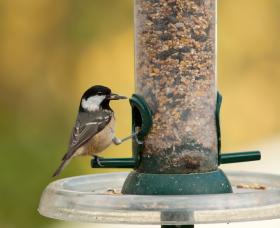Birds that flock to feeders are more likely to get sick, spread disease

Wild songbirds that prefer to eat at bird feeders have an increased risk of acquiring a common eye disease. In turn, these birds also spread the disease more quickly to their flock mates, according to an international research team led by Virginia Tech scientists.
The researchers found that this feeding preference, rather than its social position in the flock, as previously thought, was more likely to result in a bird contracting the eye disease. The results of the study, funded by the National Science Foundation, were published Wednesday in the journal Proceedings of the Royal Society B.
“Our results suggest that in this species, a few individuals — those that like eating at feeders — are likely very important in driving disease epidemics,” said Dana Hawley, an associate professor of biological sciences in the College of Science, a Fralin Life Science Institute affiliate and member of the Global Change Center at Virginia Tech. “If this is true for other wildlife species as well, we may be able to more effectively reduce disease by targeting these ‘high risk’ individuals.”
The authors monitored the social and foraging behaviors of wild flocks of house finches, a common backyard songbird, and the spread of a naturally-occurring bird disease called Mycoplasmal conjunctivitis, which is similar to “pink eye” in humans but cannot be contracted by humans. Infected birds have red, swollen eyes that can lead to blindness, and ultimately, death, as a result of not being able to see.
In the study, each bird was fitted with a unique chip containing a barcode that automatically recorded each time a bird visited one of the monitored bird feeders over an entire winter. When bar codes from different birds appeared at feeders around the same time, the researchers knew that those two birds were feeding together.
“This technology enabled us to capture where birds fed during the winter and who they chose to feed with,” said Sahnzi Moyers of Portland, Oregon, a doctoral student in biological sciences in the College of Science, who works with Hawley.
The researchers used this data to reconstruct the birds’ social networks. Birds that were frequently seen together had stronger bonds. Based on previous work, the authors expected that birds that had many connections would be more likely to be exposed to the disease and to spread it.
Source:
Environmental News Network. 17 September 2015. Retrieved from http://www.enn.com/wildlife/article/48983

